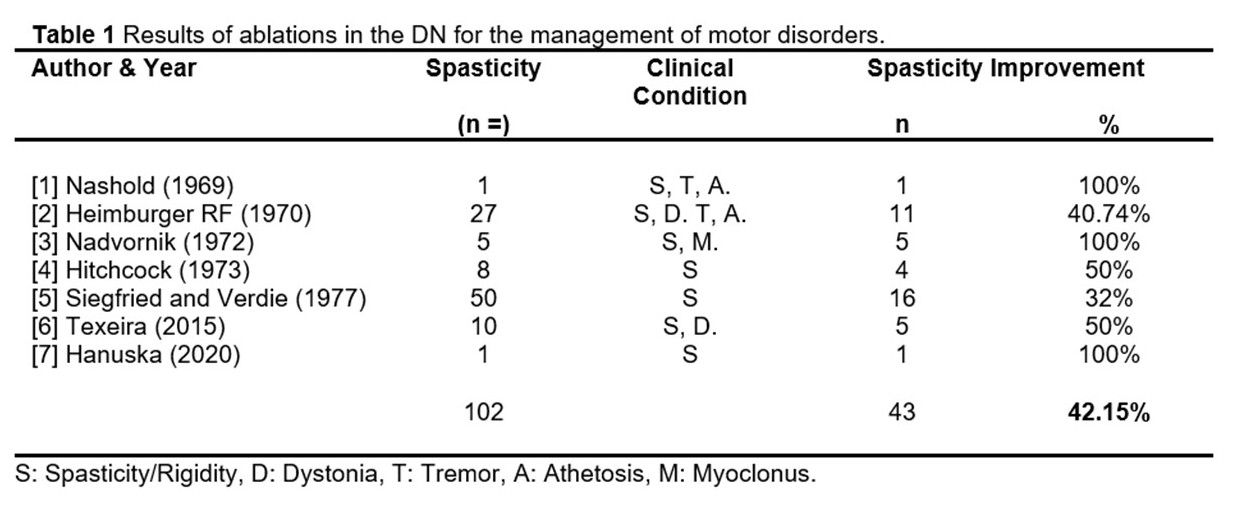Objective: Evaluate the antecedents about the clinical outcomes of stereotactic dentatotomy in the management of diverse motor disorders.
Background: The dentatotomy is a surgical technique that consists in the ablation of the dentate nucleus, it was performed for the first time in 1935 by Delmas-Marsalet, having popularity in the 70’s years for the management of motor disorders and later abandoned for more of 3 decades for its variable results and the arrival of new surgical techniques.
Method: An advanced search in Pub Med was carried out using Mesh terms; “Cerebellar Nuclei” as Major Topic and “Surgery” as subtopic, obtaining a total of 37 results. Data extraction was focused on collecting the clinical outcomes of individuals with various types of motor disorders undergoing stereotactic dentatotomy. Descriptive statistics were used for the analysis, calculating the proportion of improvement after the intervention in the various motor disorders studied.
Results: The authors of the 7 articles included (Table 1) studied the clinical outcomes of patients undergoing dentatotomies to improve clinical situations such as Athetosis, Tremor, Myoclonus, Dystonia and Spasticity. Stereotactic dentatotomy proved to be effective in patients with spasticity, showing a proportion of improvement in 42.15% of cases, followed by dystonia, being the second disorder that showed the highest proportion of improvement after the intervention.
Conclusion: The abandonment of this surgical technique is related to the variable results conditioned by the difference in clinical conditions, the use of different locations and sizes of lesion. Technological advances such as tomography-guided stereotaxy and new imaging studies allow the implementation of procedural innovations, positioning dentatotomy as a surgical alternative that shows improvement in patients with spasticity and dystonia.
References: [1] Heimburger, F. The Role of the Cerebellar Nuclei in Spasticity. Confin Neurol. 1970;32(2):105-113. [2] Nashold BS, Slaughter DG. Effects of Stimulating or Destroying the Deep Cerebellar Regions in Man. J Neurosurg. 1969 Aug;31(2):172-186. [3] Nádvorník P, Šramka M, Lisý L, Svička I. Experiences with Dentatotomy. Confin Neurol. 1972;34(5):320-324. [4] E Hitchcock. Dentate lesions for involuntary movement. Proc R Soc Med. 1973 Sep; 66(9): 877–879 [5] B Guidetti, B Fraioli, Neurosurgical treatment of spasticity and dyskinesias Acta Neurochir (Wien) 1977;24:27-39 [6] Siegfried J, Verdie JC. Long-Term Assessment of Stereotactic Dentatotomy for Spasticity and Other Disorders. Acta Neurochir (Wien). 1977;24:41-48. [7] Teixeira MJ, Schroeder HK, Lepski G. Evaluating cerebellar dentatotomy for the treatment of spasticity with or without dystonia. Br J Neurosurg. 2015;29(6):772-777.
To cite this abstract in AMA style:
A. Armas Salazar, JD. Carrillo Ruiz. Role of the Stereotactic Dentatotomy for the management of Movement Disorders [abstract]. Mov Disord. 2021; 36 (suppl 1). https://www.mdsabstracts.org/abstract/role-of-the-stereotactic-dentatotomy-for-the-management-of-movement-disorders/. Accessed April 26, 2025.« Back to MDS Virtual Congress 2021
MDS Abstracts - https://www.mdsabstracts.org/abstract/role-of-the-stereotactic-dentatotomy-for-the-management-of-movement-disorders/

